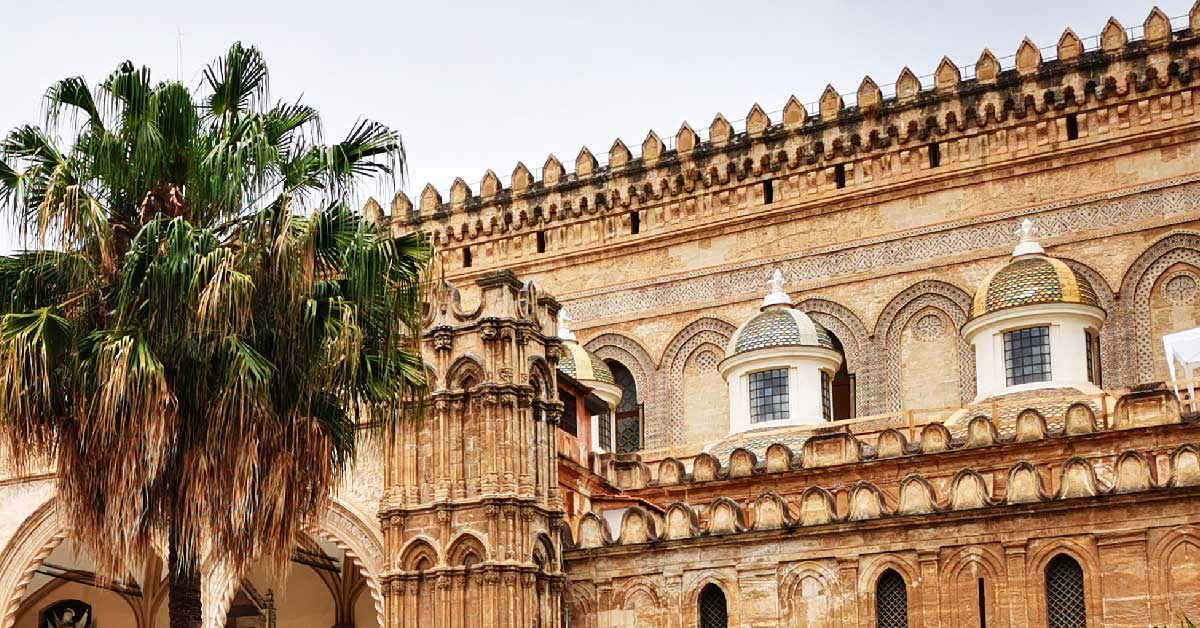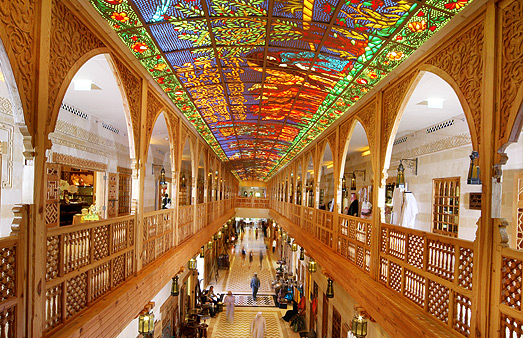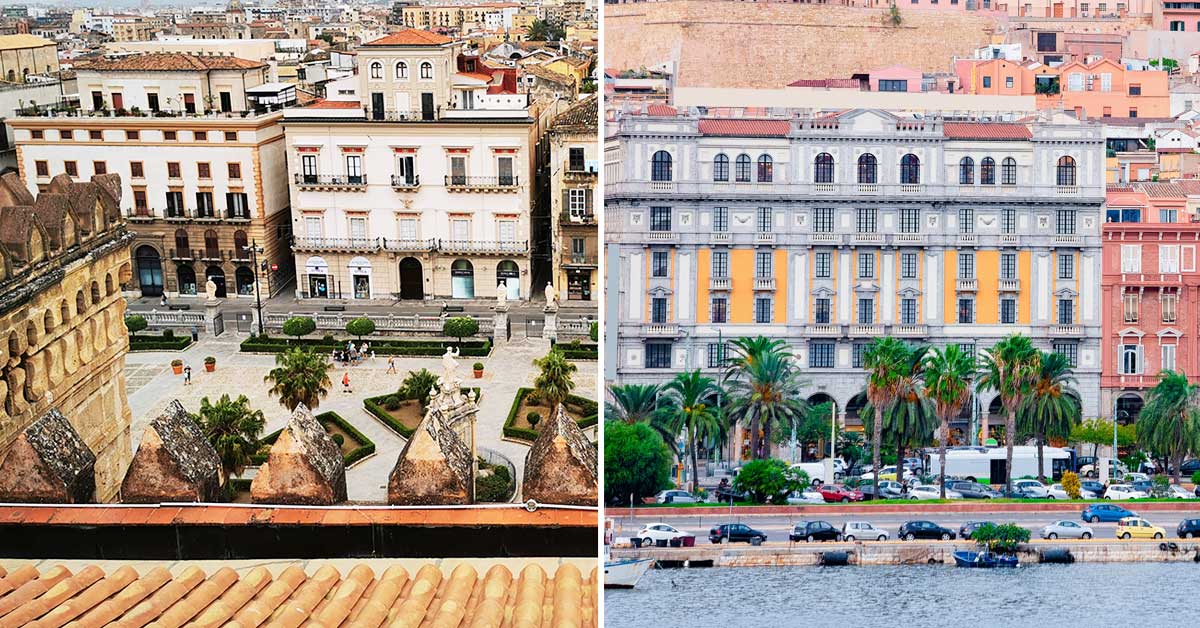10 Wonderful Reasons Why Palermo Sicily Is Worth Visiting in 2024
Is a trip to Palermo worth it? What is Palermo known for and what makes it a must-visit destination? Here’s a compelling list of reasons that will have you eagerly packing your bags and set you on your way to Sicily.
Palermo, the capital city of the Italian island of Sicily, is a destination with such a rich history and cultural diversity that would be a shame to not have it included on your summer bucket list.
With its origins dating back to over 2,700 years ago, Palermo stands as a testament to multiple civilizations that have influenced its architecture, cuisine, and traditions. Being nestled along the coast of the Tyrrhenian Sea, the city has always been a crucial naval and trading hub for the Mediterranean, a strategic point many wished for and eventually conquered.
Today, Sicily’s capital is a direct result of its tumultuous past under the rule of Greeks, Romans, Byzantines, Arabs, Normans, and Spaniards. And that alone is intriguing enough to make you wanna see it.
Disclosure: This article contains affiliate links. If you make a purchase after clicking one of these links, I earn a small commission from that website at no extra cost to you. Learn more: Disclosure policy.
 What Is Palermo Known For? Why Visit It?
What Is Palermo Known For? Why Visit It?
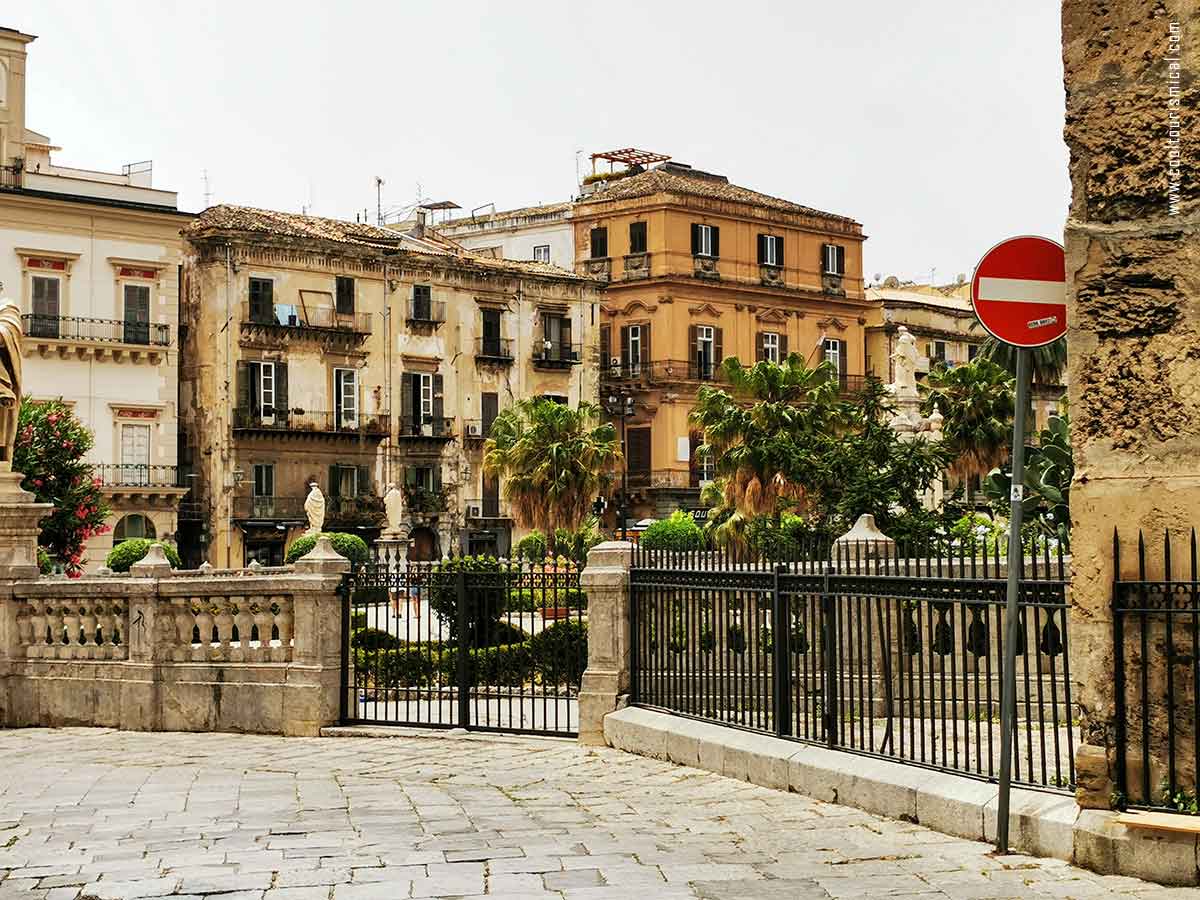
Palermo, Sicily, Copyright © Cooltourismical.com
Why Palermo Sicily? If you’re ready to see and experience a wonderful chaos, a city that that has fought for its survival for more than 2.5 millenniums, then this is it. Particularly conquered and reconquered for thousands of years and having a pretty recent history of Mafia, Palermo is nowadays one very safe, but extremely underrated travel destination.
I would say it is impossible for one to not fall in love with Palermo. Its distinctive charm due to the mix of countless cultures and the Italian-rooted “la dolce vita” philosophy, makes it cozy and mysterious. On this matter, nothing on the World Wide Web can describe the actual atmosphere ruling the streets.
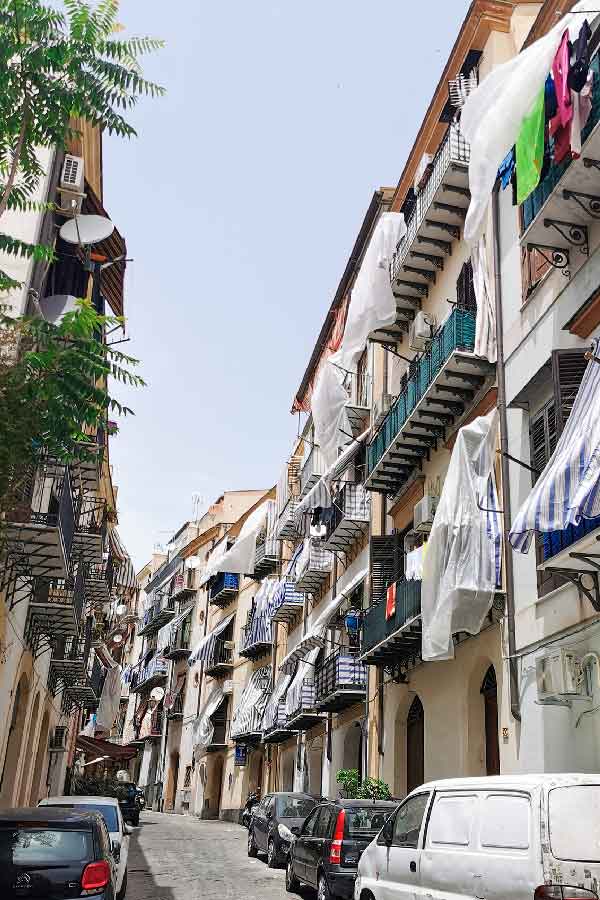
Streets of Palermo, Sicily, Old Center, Copyright © Cooltourismical.com
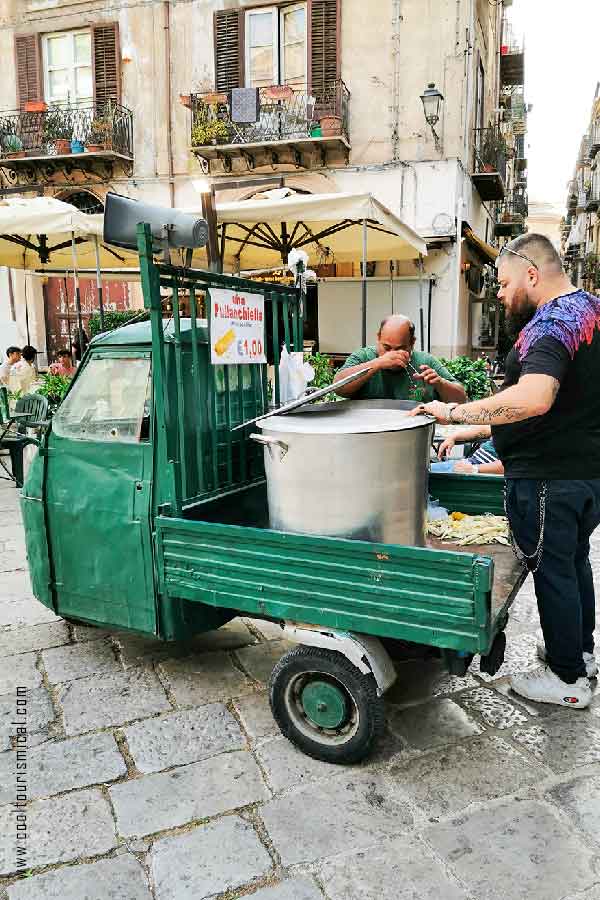
Corn Seller in Palermo, Sicily, Old Center, Copyright © Cooltourismical.com
Strong, medieval walls with their tiny, chic balconies line up narrowing stone-paved streets. Sometimes, these places even feel like some secret corridors. All beautifully decorated with plants, auspicious ceramic pinecones or colourful Teste di Moro speaking of lost love. And when we least expect it, lively historical piazzettas and Arab-style markets pop-up from nowhere.
Behind the walls, lie hidden, small, intimate living spaces, where your neighbours feel so close to you that they can’t be anything else, but your friends.
Welcoming, kind, energetic, Palermo is like a home where you drive your car directly into the living room to park it, and remarkably, no one minds.
While some of the streets in the old city may face minor cleanliness challenges, and a few building facades show signs of wear, Palermo’s cultural richness goes way, way beyond that. The hotels are impeccably clean, the cuisine is absolutely delightful, and the many palaces are incredibly beautiful.
Now, let’s explore in more detail the main reasons that make Palermo a must-visit destination.
 For The Exquisite Sicilian Food
For The Exquisite Sicilian Food
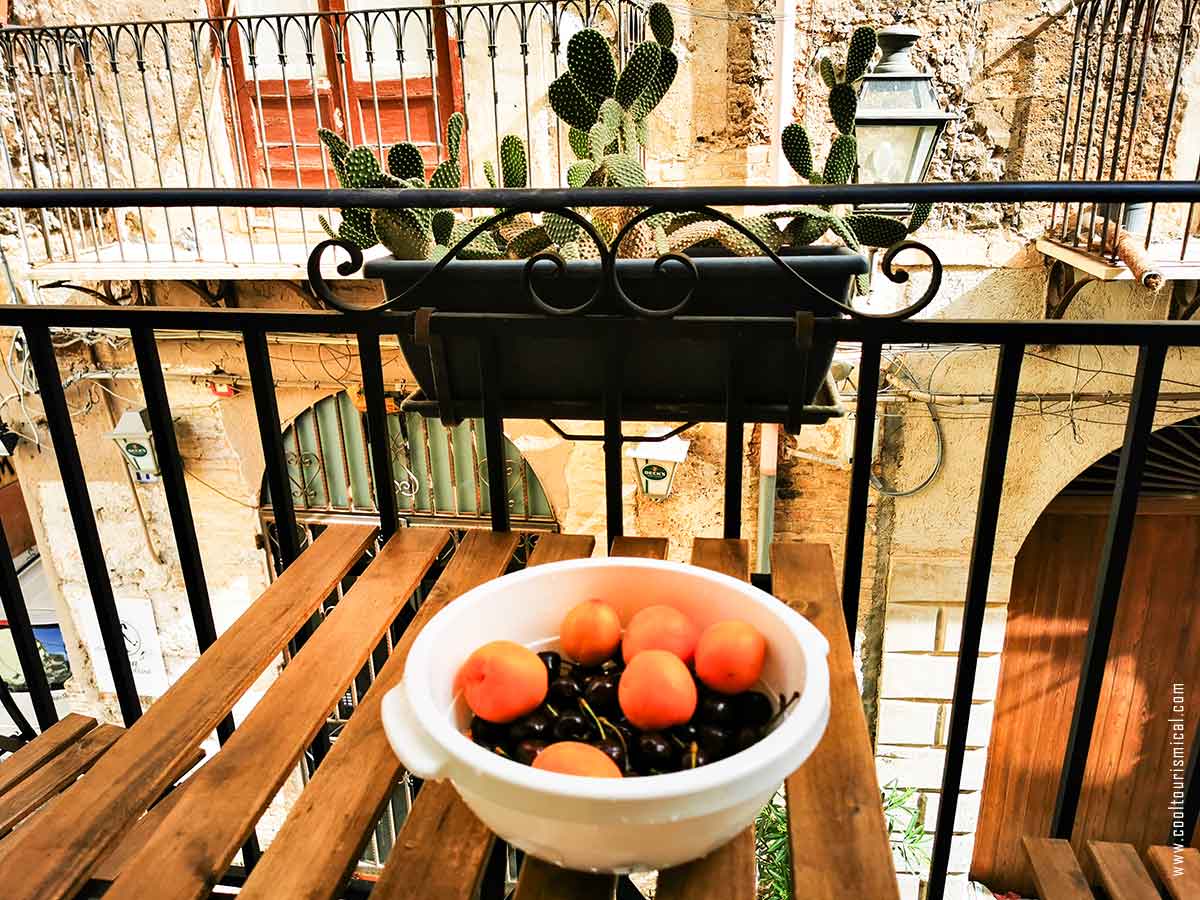
Cherries & Apricots from El Capo Market, Copyright © Cooltourismical.com
Palermo is the paradise for foodies. And that’s my main reason I would always go back for.
Due to its Mediterranean climate, Sicily has a large variety of fruits and vegetables grown locally, in the countryside, throughout the year. That is why Palermo’s ancient markets burst with fresh sweet cherries, watermelons, artichokes, olives, tomatoes, and citrus, especially the Sicilian blood orange that can’t be exported, Tarocco. Notably, 67% of Italy’s citrus farms are located in Sicily!
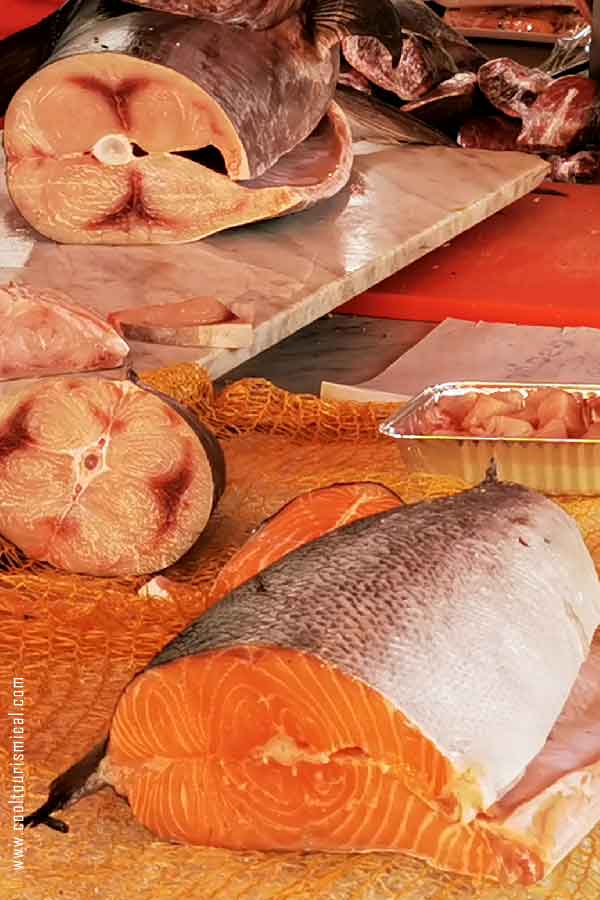
Salmon in Capo Market, Copyright © Cooltourismical.com
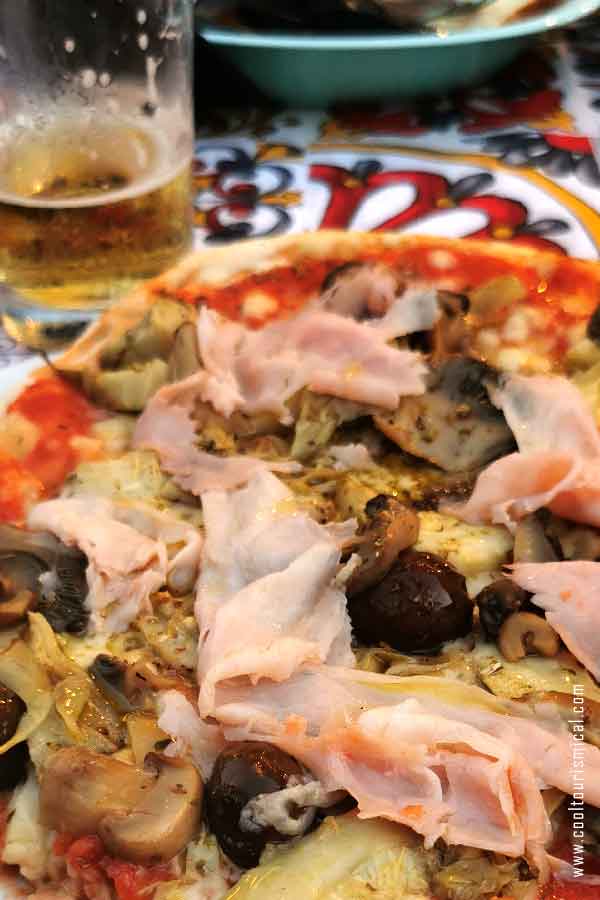
Sicilian Pizza at All’Olivella, Copyright © Cooltourismical.com
On the same tiny streets filled with vendors shouting old chants, the stalls receive each morning seafood straight from the ocean. Gigantic octopuses, swordfish heads, Gambera red prawns and sea urchins lie in the shadow waiting to be part of some delicious meal. Most often, you’ll also find salted or dried fish, like ‘baccalà’ (salted cod), an old tradition that’s still preserved around the island.
The nearby restaurants transform all these delicacies in some of the most famous Italian plates. Of course, with a touch of Greek, Roman, Arab, and Norman traditions and scents. You should definitely try the creamy seafood risotto, stuffed sardines, or ‘orata al forno’, a whole sea bream baked with herbs, lemon, and olive oil, a classic. Pasta dishes are a staple too, with variations like spaghetti with sea urchins (spaghetti ai ricci), pasta with sardines (pasta con le sarde), and pasta with clams (pasta alle vongole).
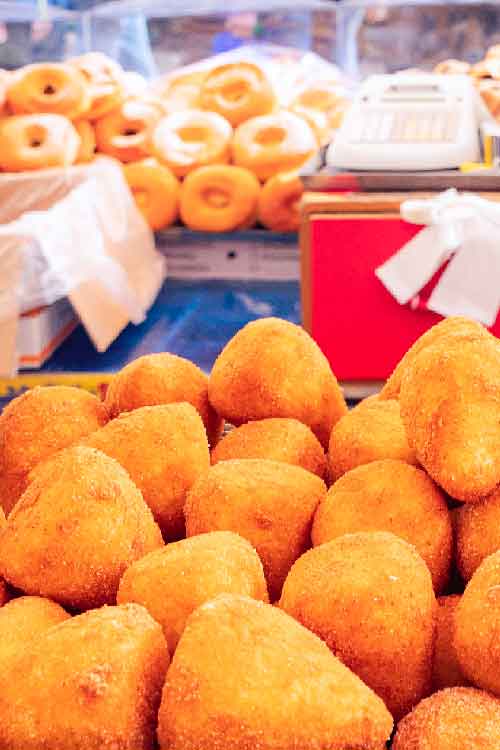
Arancini (Italian Rice Balls), Source: Artyart / FREEPIK
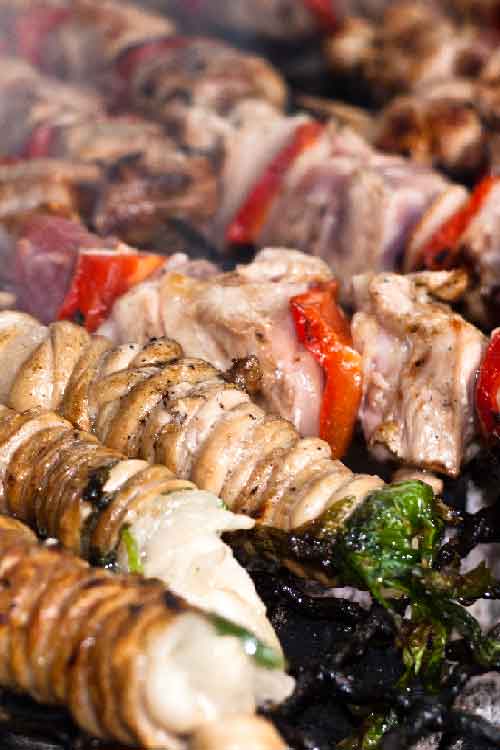
Stigghiola, Source: Gandolfo Cannatella / FREEPIK
Impossible to miss out on Palermo’s street food, especially the deep fried Arancini (rice balls crispy on the outside and filled with ragù (meat sauce), cheese, or peas), Panelle (chickpea fritters), Pane con la Milza (spleen sandwich), Stigghiola (grilled lamb intestines skewers, seasoned with salt and lemon and the thick, fluffy Sicilian pizza called Sfincione.
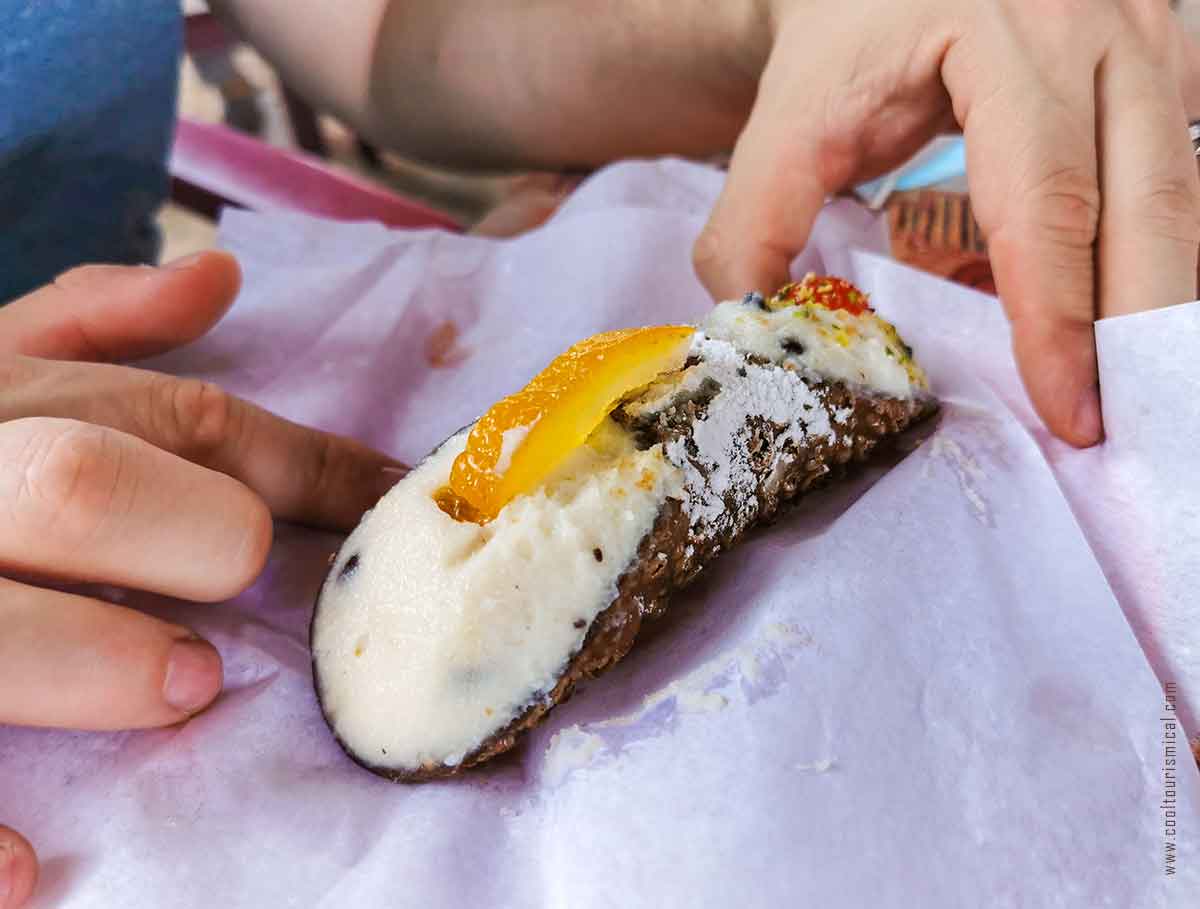
Cannoli at Bar Santoro, Copyright © Cooltourismical.com
Cannoli is perhaps the most famous Sicilian dessert, tube-shaped shells of fried pastry dough, filled with ricotta cheese and sprinkled with pistachios, chocolate chips, or candied fruit. Cassata Siciliana is my second favorite, a traditional fruit-infused sponge cake layered with ricotta cheese and covered in marzipan.
Spicy goat cheese, Modica chocolate and the wines from the volcanic soils of Mount Etna add new cultural dimensions to the already rich food scene.
📌 Tips & Tricks: For really tasty Sicilian food, check my list of Best Restaurants in Palermo.
 For the Amazing Ancient Art & Architecture
For the Amazing Ancient Art & Architecture
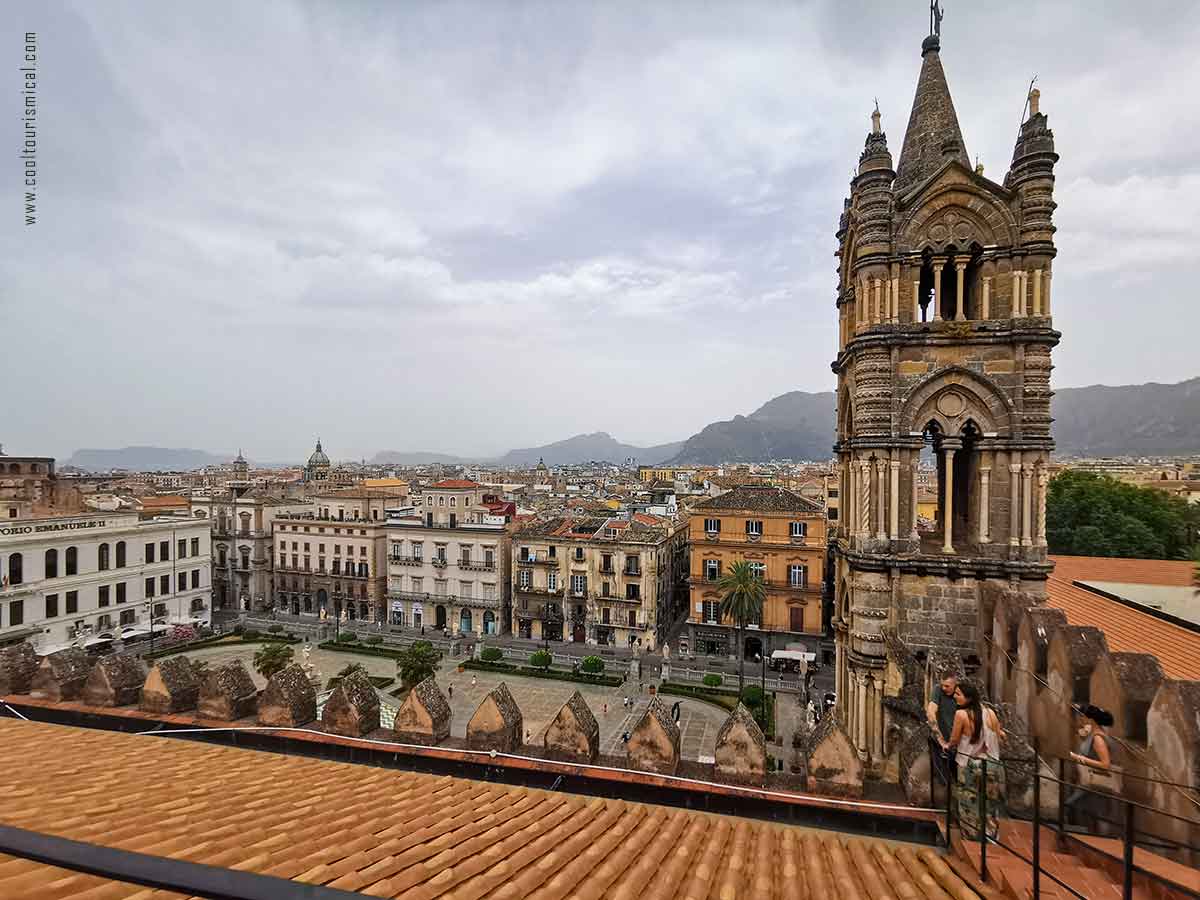
Albergheria District Seen from the Cathedral, Palermo, Sicily, Copyright © Cooltourismical.com
After wandering through the streets of Palermo, one quickly realizes that the whole architecture, still standing after centuries, is a genuine storybook, speaking about so many civilizations that passed by. This is another strong reason for which Palermo is worth visiting.
The whole of Palermo is like a mosaic of buildings from various eras, obviously displaying a diversity of cultural influences. Frequently, these different styles coexist even within the same space. From the nearly vanished structures of Greeks and Phoenicians to the Romans’ sturdy villas and Byzantine mosaics, surrounded by Moorish arcades and gardens, and everything remodelled and extended by the Normans, just before the Spaniards brought in the fancy Renaissance and Baroque details, – that’s the essence of Palermo.
Some must-visit spots in Palermo show all these various touches. For example, the Norman Palace (Palazzo dei Normanni), originally a 9th century structure and Moorish fortress, was expanded by the Normans. The Palace is renowned for its unusual combination of Byzantine mosaics and Arab muqarnas inside its Palatine Chapel.
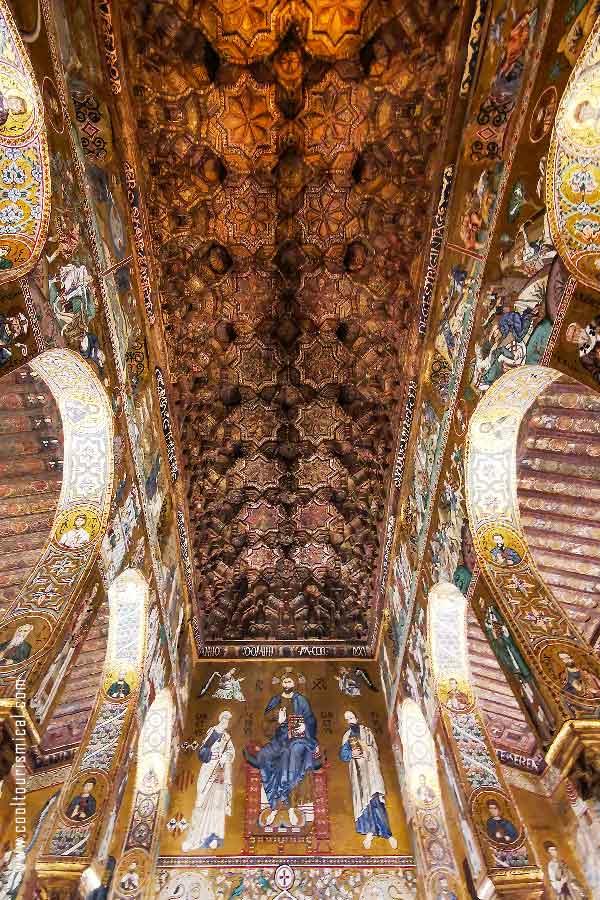
The Palatine Chapel Ceiling, Copyright © Cooltourismical.com
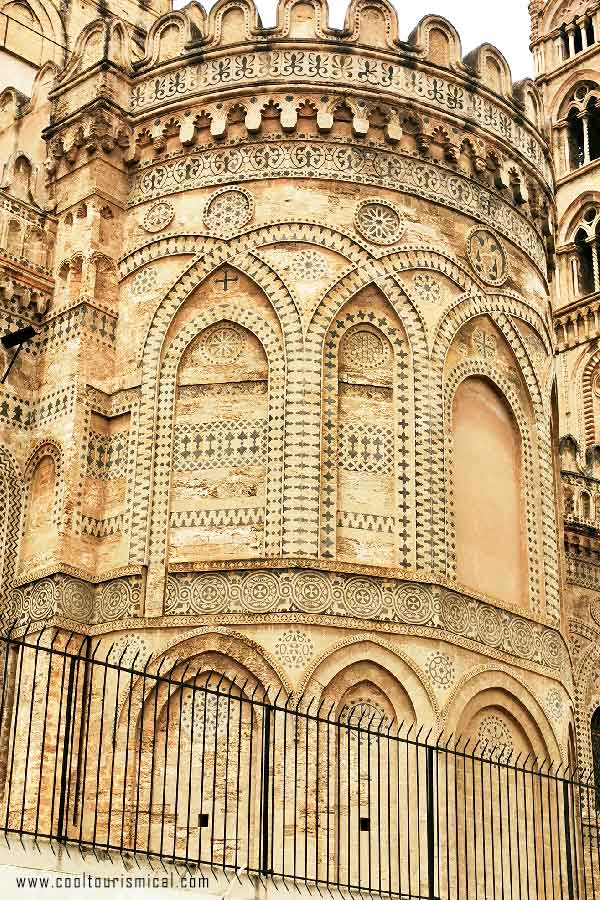
Arab-Norman Cathedral, Copyright © Cooltourismical.com
Not far from it, Palermo Cathedral (Cattedrale di Palermo), dating back to 12th-century, is famous for its eclectic style, a stunning combination of Norman, Moorish, Gothic, Baroque, and Neoclassical architecture, and decorations. Other old churches like the Church of San Cataldo and Santa Maria dell’Ammiraglio (La Martorana) also exhibit beautiful Byzantine mosaics and Islamic influences in their architecture.
Worth mentioning are the stunning nobility villas and smaller palazzos built in the 17th or the 18th century like Palazzo Conte Federico, Villa Malfitano or Mirto Palace, some surrounded by the most exquisite gardens.
Added to those, Teatro Massimo is a prime example of 19th century neoclassical architecture and is one of the largest theatres in Europe, known for its impressive interior.

Fontana Pretoria Statue, Copyright © Cooltourismical.com
The Quattro Canti square, located at the intersection of Via Vittorio Emanuele and Via Maqueda, is an excellent example of Baroque architecture. Meanwhile, the nearby Fontana Pretoria, known as the Fountain of Shame, is a notable Renaissance-era landmark. It features a ring of 16 marble statues surrounded by a massive circular fountain, with Greco-Roman mythological representations.
Lastly, the Capuchin Catacombs give a unique glimpse into how people in Palermo used to bury their dead.
Actually, architecture tops the list of reasons to visit Palermo.
📌 Read More: Full list of best things to see in Palermo, a guide to architectural gems.
 For the Exotic, Lush Vegetation
For the Exotic, Lush Vegetation
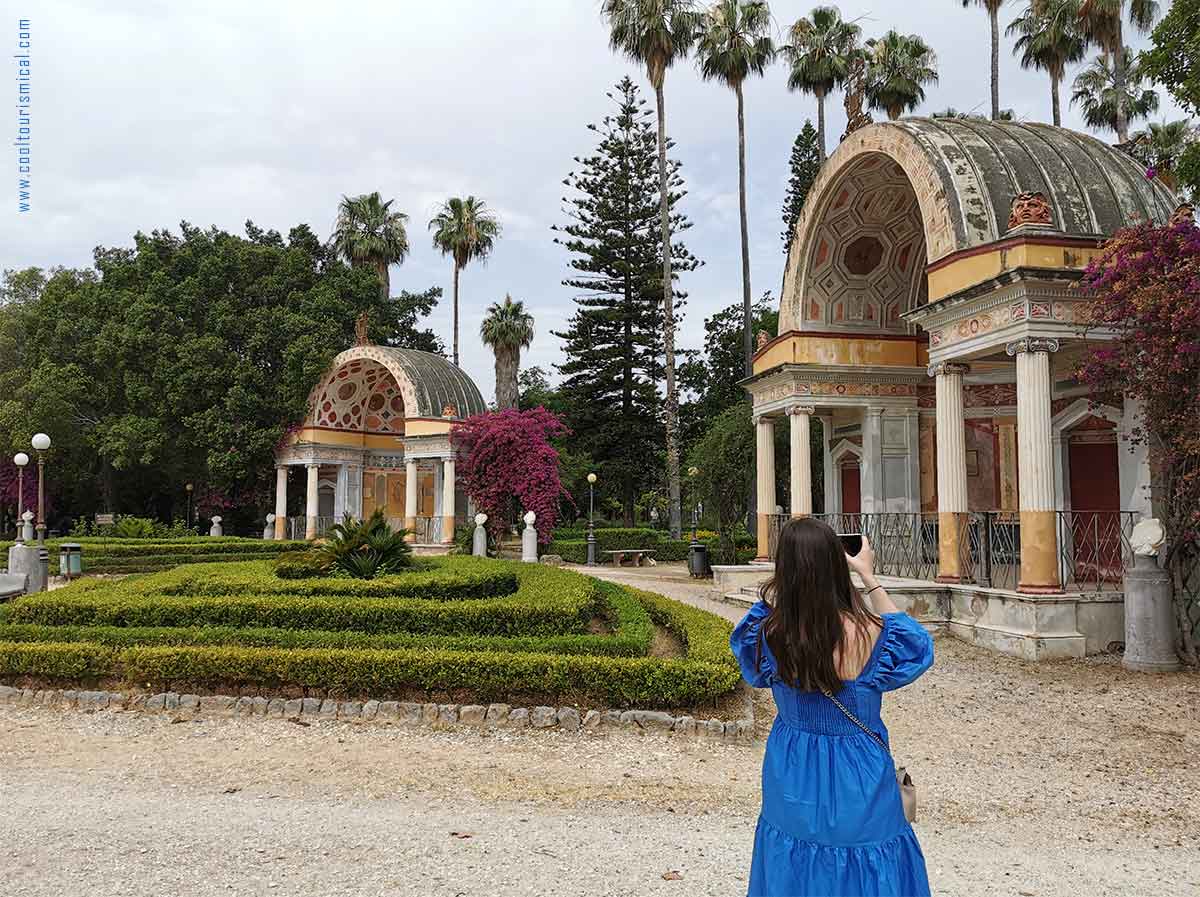
Villa Giulia in Palermo, Copyright © Cooltourismical.com
The leafy beauty of Palermo has been around the city since Arab and Norman times. And it’s one of the significant draws for the tourists. Peaceful retreats around castles and villas (The Gardens of the Norman Palace or Villa Malfitano), public oases such as Villa Giulia or Orto Botanico, partially park, partially research institute, are most notable of the many gardens of Palermo.
But the enchanting blend of native and exotic species, a result of the diverse cultural influences, combined with the Mediterranean environment perfect for robust plant growth, is what makes Palermo as extraordinary, as it is unusual.
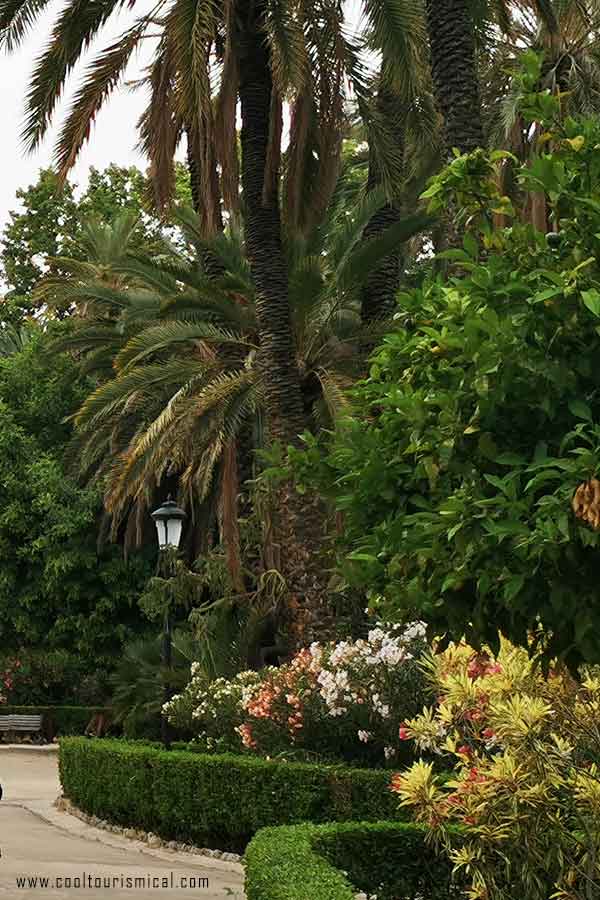
Villa Bonanno Palermo, Copyright © Cooltourismical.com
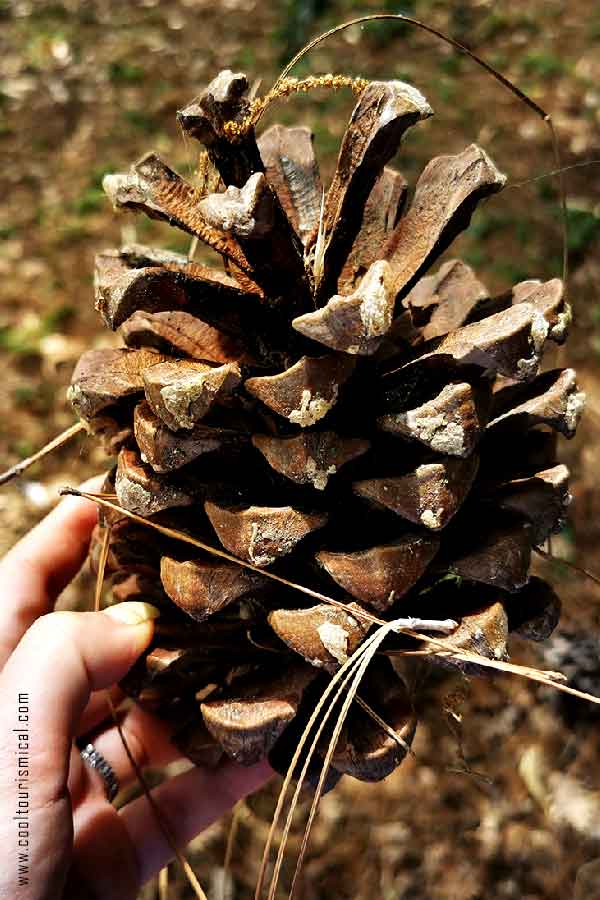
Gigantic Pine Cone at Orto Botanico Palermo, Copyright © Cooltourismical.com
Most common trees for Palermo are oak and pine trees. Plus, palms that touch the sky, such as Canary Island Date Palm or Mexican Fan Palm, line up many of Palermo’s streets and parks. At their feet, you can often find Mediterranean Maquis, densely growing evergreen shrubs like myrtle, juniper, and various aromatic herbs like rosemary and thyme. Epic bamboo trees surround ponds with white lilies. And just meters away, you can spot some really gigantic cacti and succulent plants filling green grass urban islands.
All these plants, as different as they are, thrive in peace in the same warm, welcoming climate, with abundant sunlight, fertile soil, and enough water.Still, the most famous of all is not even a Palermo native, just brough and adapted to the climate for centuries: Ficus macrophylla (Moreton Bay Fig). The ficus trees in Palermo are quite impressive specimens, some of the greatest in Europe.
Moreover, the region around Palermo is famous for its citrus groves and olive trees. That makes the whole landscape to be impressive.
📌 Read More: Ready for a walk? This is what you can visit: Most Beautiful Palermo Gardens and Parks.
 For the Refined Cultural Life
For the Refined Cultural Life
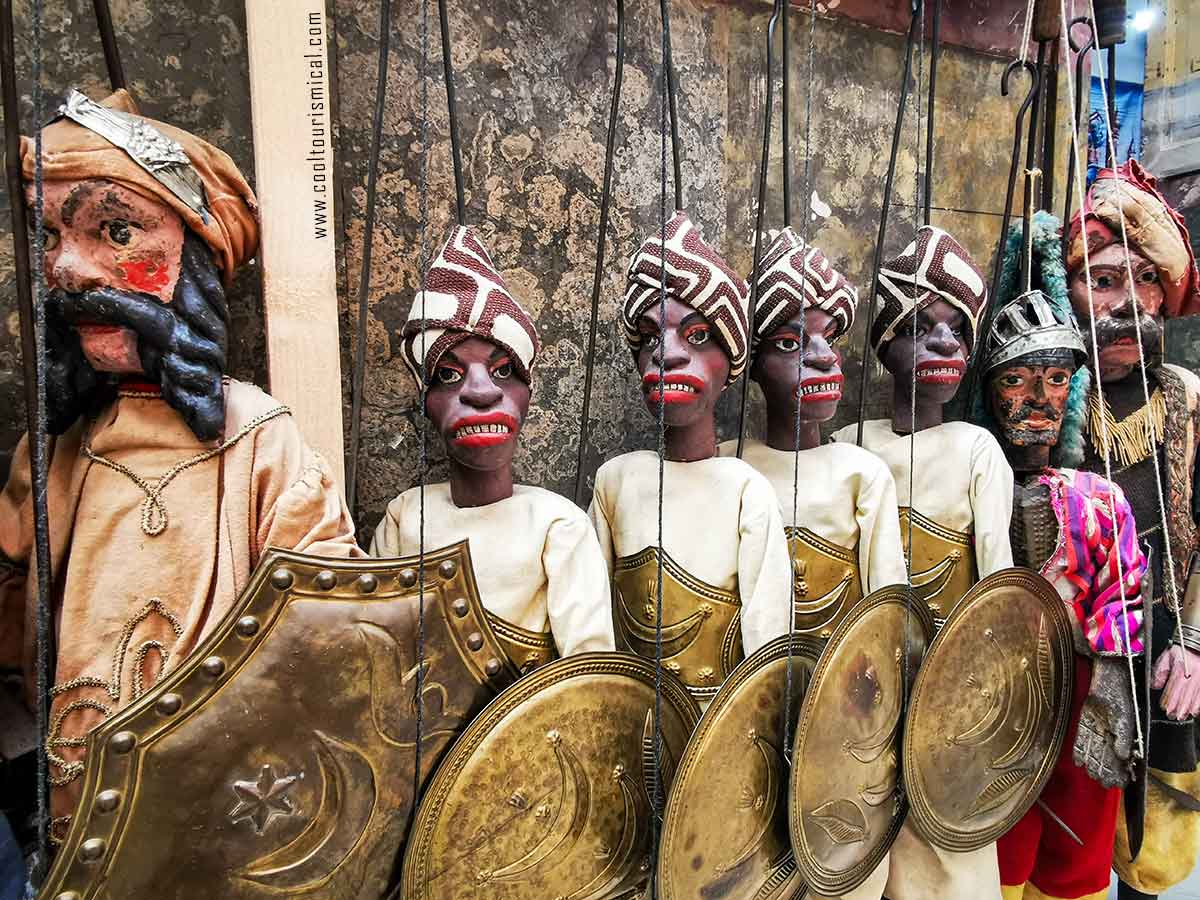
Moorish Army at Antonio Pasqualino Puppet Museum, Copyright © Cooltourismical.com
From most weird exhibitions to open-air concerts in hundreds of years old venues, traditional puppet shows and spectacular opera performances, the cultural life of Palermo has something to offer for each and everyone. As everything else, the roots of the cultural life go hundreds of years back wearing the footprint of many mingled civilizations and repeated conquests.
When you’re in Palermo, stepping into its museums is a must. The Palazzo Abatellis, for example, with its Gothic-Catalan architecture, mesmerizing frescoes and sculptures. An actual treasure trove of Sicilian art.
Another unique, and deeply cultural landmark is the Antonio Pasqualino International Puppet Museum. A significant part of the museum is dedicated to the Opera dei Pupi, a traditional Sicilian form of marionette theatre. Although the shows are just in Italian, it’s still very interesting to check in.
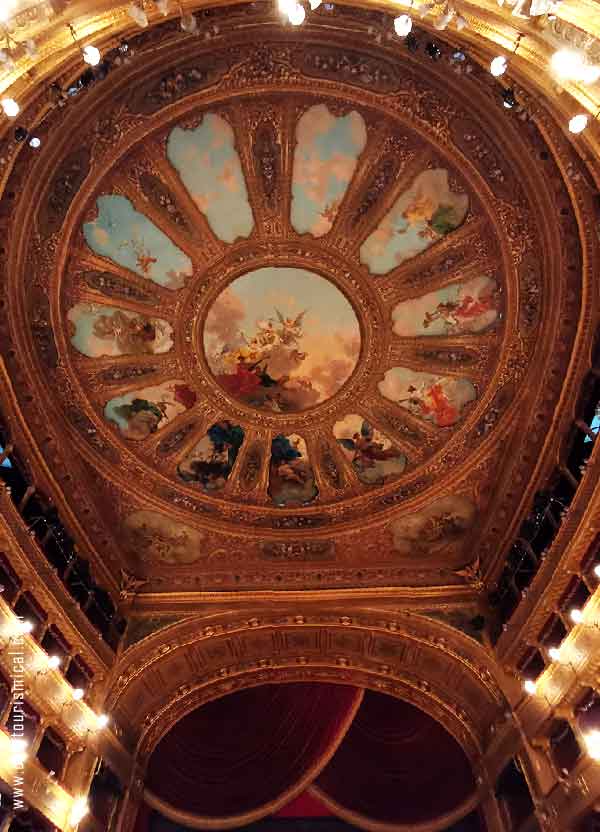
Teatro Massimo Palermo, Copyright © Cooltourismical.com
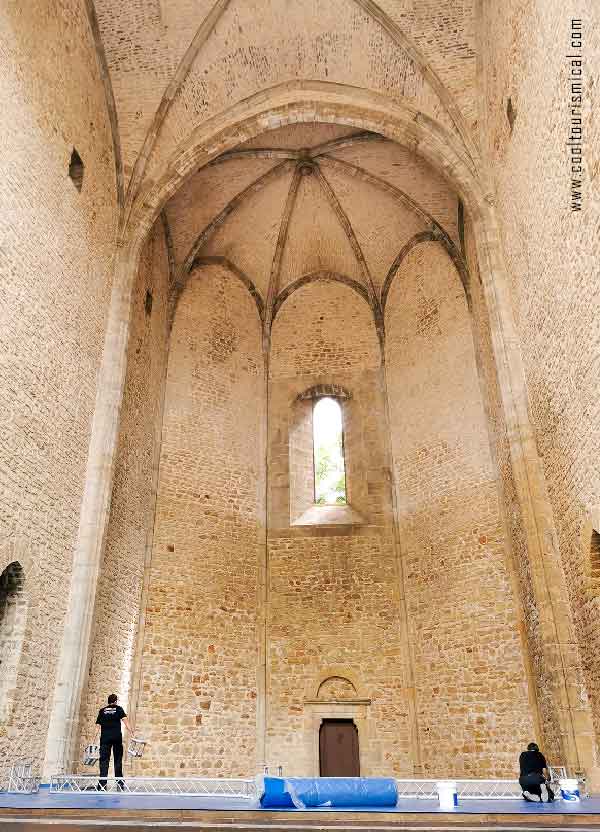
Santa Maria dello Spasimo, Copyright © Cooltourismical.com
Not to miss, Opera Season at Teatro Massimo. Known for its exquisite architecture and superior acoustics, and as one of the biggest theatres in Europe, it hosts an opera season including a mix of classic and contemporary performances.
And if you’re into Jazz, Palermo is the home of the Blue Brass Jaz Festival, using as a venue the monumental Santa Maria dello Spasimo complex – a 16th century, never-finished church in the historic area of Kalsa. Due to the many invasions, money was redirected into fortifications, and the church never got a roof, creating a unique scene for various functions along the years: form theatre to hospice for the poor and hospital. Since the 20th century, the place a frame for one of the oldest Italian jazz clubs performances hosting legends like Miles Davis or Frank Sinatra.
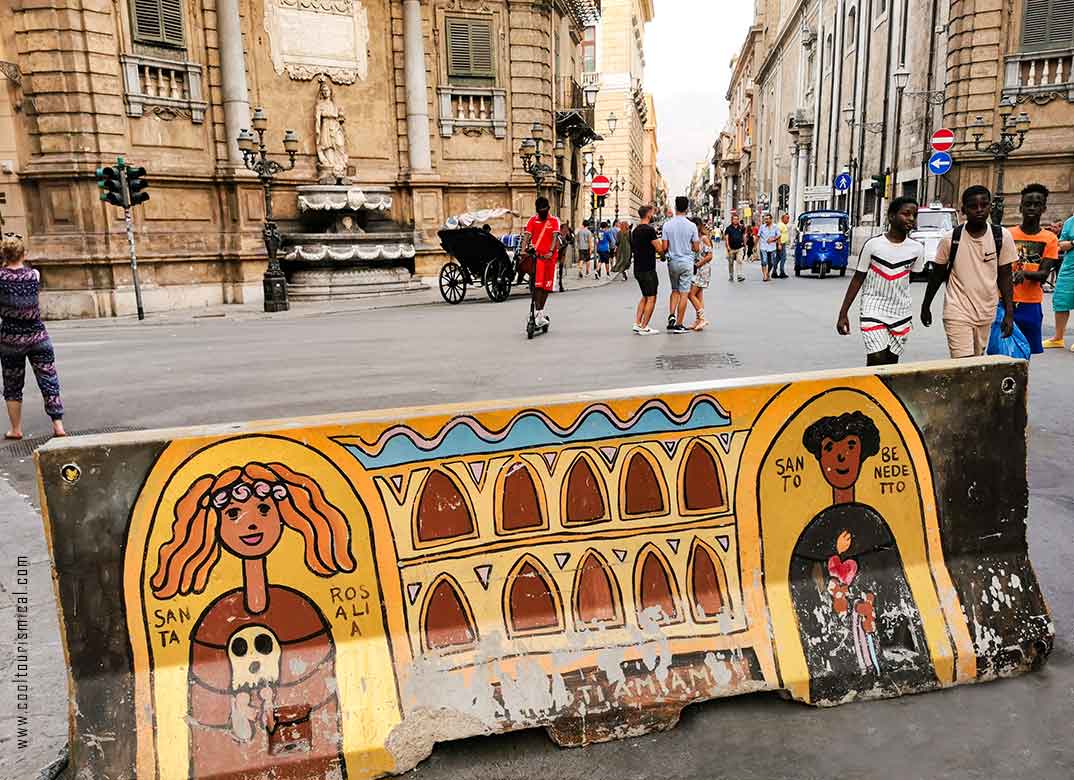
Quatro Canti, Palermo, Copyright © Cooltourismical.com
A more local tradition and one of the most important events in Palermo is the Feast of Saint Rosalia (Festino di Santa Rosalia). This is held annually in July. Saint Rosalia is the patron saint of the city, and the festival commemorates her role in saving Palermo from the plague in 1624. The event features a grand procession carrying the saint’s relics through the city, followed by fireworks, concerts, and street food vendors.
 For the Weird & Surprising
For the Weird & Surprising
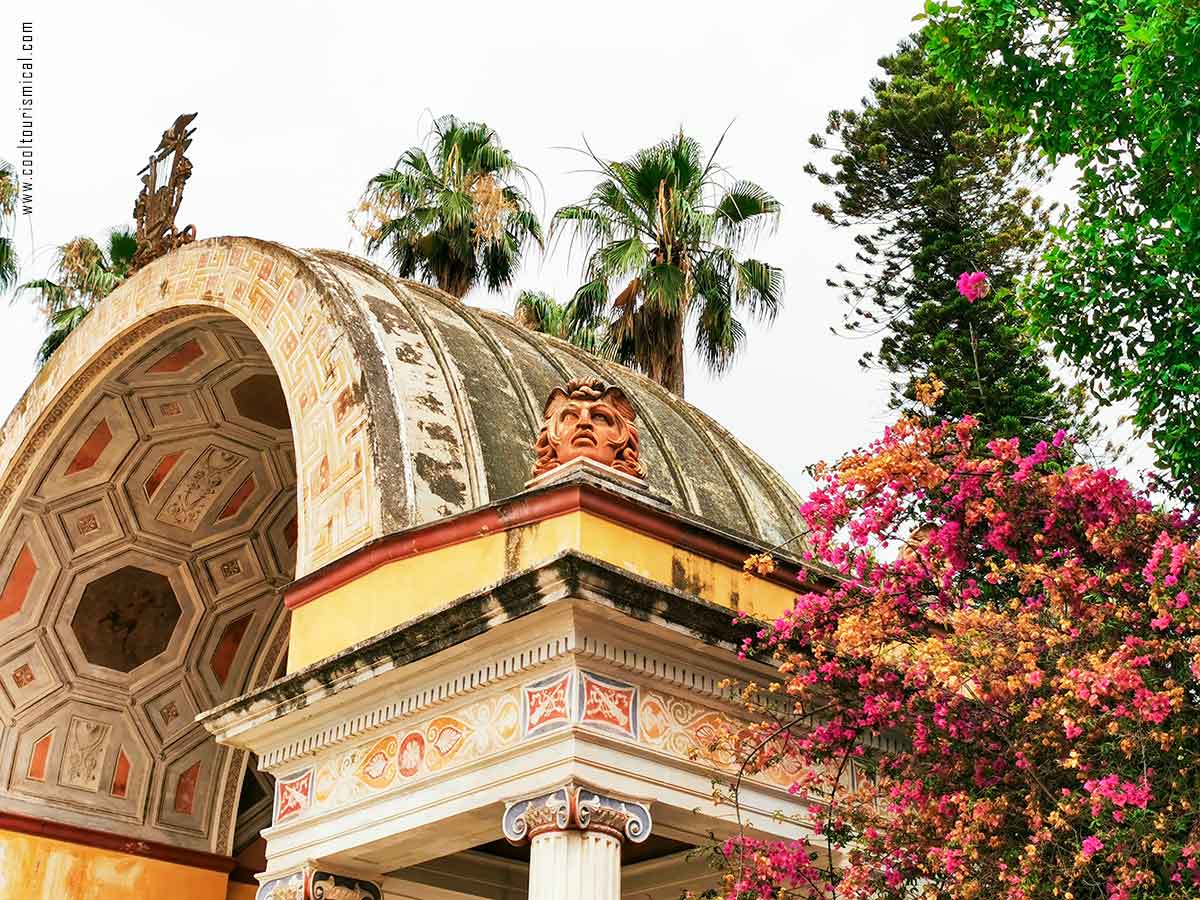
Villa Giulia, Neo-Pompeian Pavilions, Copyright © Cooltourismical.com
Seeing the sights in Palermo is quite a surprising adventure. You might start with a plan, but as you walk around, you’ll find twice as many things to see. Palermo is a city where you can never get bored, adding to its appeal as a holiday destination for explorers.
There’s always something new and exciting at every corner. Some outstanding graffities that turn urban landscapes into vibrant canvases, a palace you didn’t know about, a little secret art gallery, painted carriages, an exotic tree of unusual size, or an old architectural detail that’s been there for hundreds of years.
And, of course, the city does have a side that thrives in the peculiar. The Capuchin Catacombs, with their silent corridors of mummified history, offer a macabre yet fascinating glimpse into the past. Nearby, the surreal ruins of Santa Maria dello Spasimo, a roofless church, with the sky as its ceiling, stand as a haunting reminder of nature’s embrace over man-made architecture.
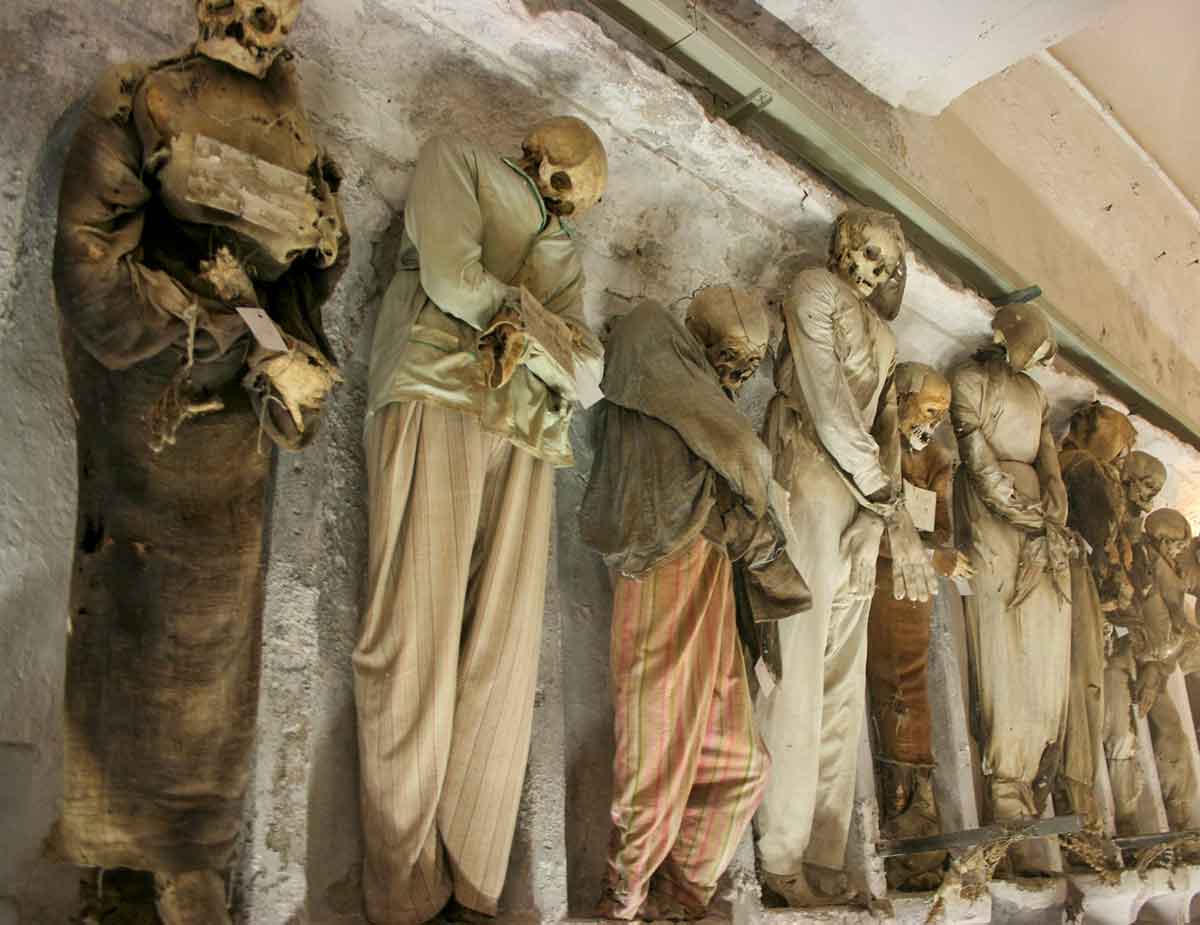
Catacombe dei Cappuccini, Copyright © Juan Antonio Segal | FLICKR, used under CC BY 2.0
Beneath the city’s surface is the Qanat, the ancient waterways. While above ground, with its playful baroque grandeur, “Fountain of Shame” in Piazza Pretoria exposes its whimsical nude statues.
On the outskirts, Isravele, the Fallen Hermit on Mount Gallo, has turned an old WW2 military light house into his home, also decorating it with most unusual mosaics.
I could say Palermo is a city unafraid to express itself that constantly surprises winning over everyone who wanders its streets in search for unconventional experiences. The weird and the wonderful are its heartbeats.
📌 Capuchin Catacombs: If you plan to visit it, you can buy your tickets in advance on Viator.
 For the Smoky Nightlife
For the Smoky Nightlife
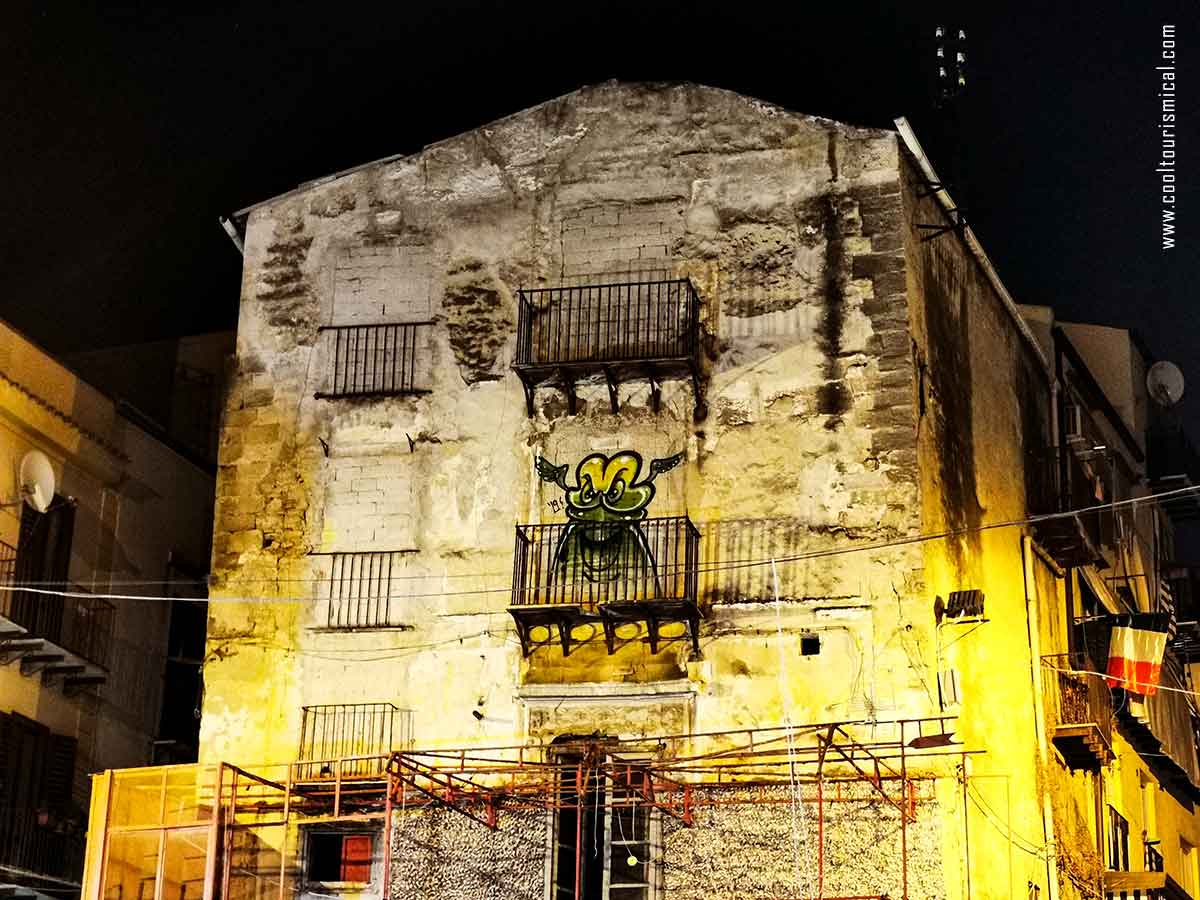
Vucciria Market at Night, Copyright © Cooltourismical.com
Another important aspect in choosing to visit Palermo is its nightlife.
When the sun sets down, the old city center of Palermo wakes up. Accordingly, tables pop-up in the middle of the road, even where you’d have never expected them to be. On the main streets like Maqueda, in hidden gardens, public plazas or the famous historical markets. All in all, as surprising as it might be, tiny cars make their way less than 1-meter distance from your table, splitting the crowds.
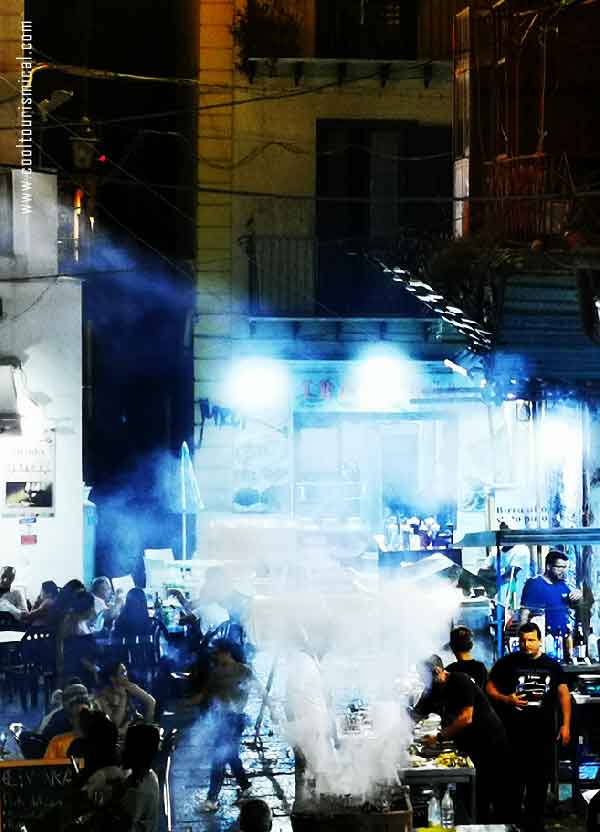
Street Food in Vucciria, Copyright © Cooltourismical.com
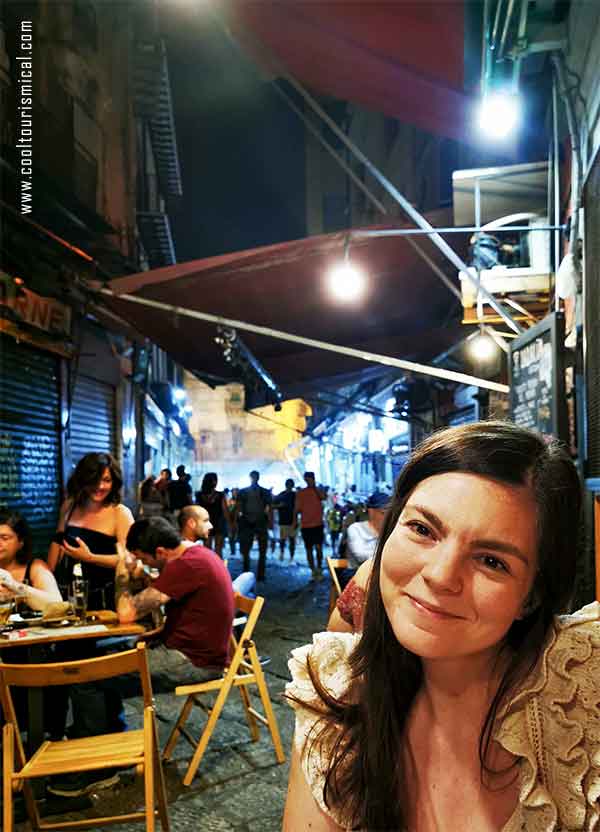
At Dadalia Oisteria, Copyright © Cooltourismical.com
During my last visit to Palermo, I spent a good amount of time in an Airbnb very close to Vucciria market.
After dark, the fish and vegetables market became the stage for a buzzing nightlife. All stores closed and lots of restaurants and bars opened. Surrounded by the smoke of street food and dim lights, Vucciria was getting filled each and every evening with so many people of all ages, tourists and locals alike, coming together to enjoy the music, have a drink while chatting loudly or join a fancy dinner in an Osteria.
From the markets, fun extends along via Vittorio Emanuele, and, especially on Via Maqueda (where I do recommend also paying a visit to Mak Mixology for live music during the weekends and most delicious cocktails). Then, the chatter moves further, to upper class neighbourhoods, such as Politeama Libertà, in the lovely wine bars and trattorias.
From the social hubs forming in the public squares like Piazza Olivella, to the rooftop bars such as the one at Ambasciatori Hotel, Palermo’s city center vibrancy and charm are undeniable. And the old architecture provides the perfect backdrop to all these gatherings.
Plus, even if you’re not going out for drinking or sizzling sea food, you can still enjoy the party. A gelato under the moonlight doesn’t sound bad either when you’re spending your summer in Italy.
Night Tours in Palermo
 For the Most Colorful Souvenirs Ever
For the Most Colorful Souvenirs Ever
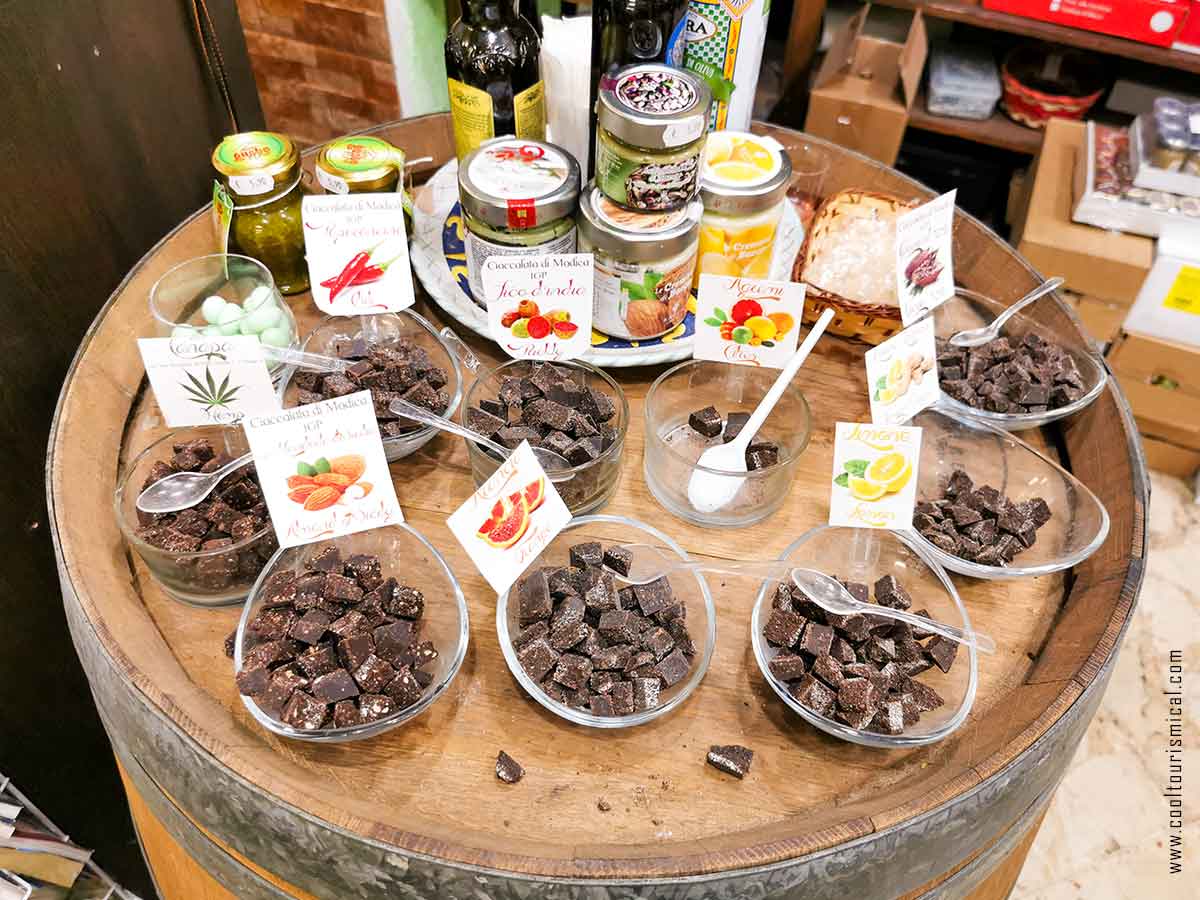
Modica Chocolate at L’Emporio Souvenir Store, Copyright © Cooltourismical.com
If you’re planning to go on a shopping spree in Palermo, then you’re definitely not wrong.
Palermo has the most colorful and varied Sicilian souvenir scene, reflecting such a lovely and meaningful cultural heritage. From Moorish heads hiding old love stories to auspicious pinecones, along with the famous and extremely beautiful majolica tiles, ceramics are the most fascinating of all things you could bring home from Sicily.
That, plus coppola hats, marionette puppets and lots of foods: chocolate from Modica, Marsala wine, olive oil and giant bags of colorful, weirdly shaped pasta.
Best shopping places in the old center are within Palermo ancient markets, Ballaro and Capo, where you can even bargain freely. They continue on Via Roma and Via Maqueda. These are the Main shopping streets lined with a mix of boutiques, museum stores and souvenir shops offering everything from high-end fashion to traditional Sicilian goodies.
📌 Best gift shops in Palermo? I recommend reading Best Palermo Souvenirs to Take Back Home.
 Outdoor Activities for All
Outdoor Activities for All
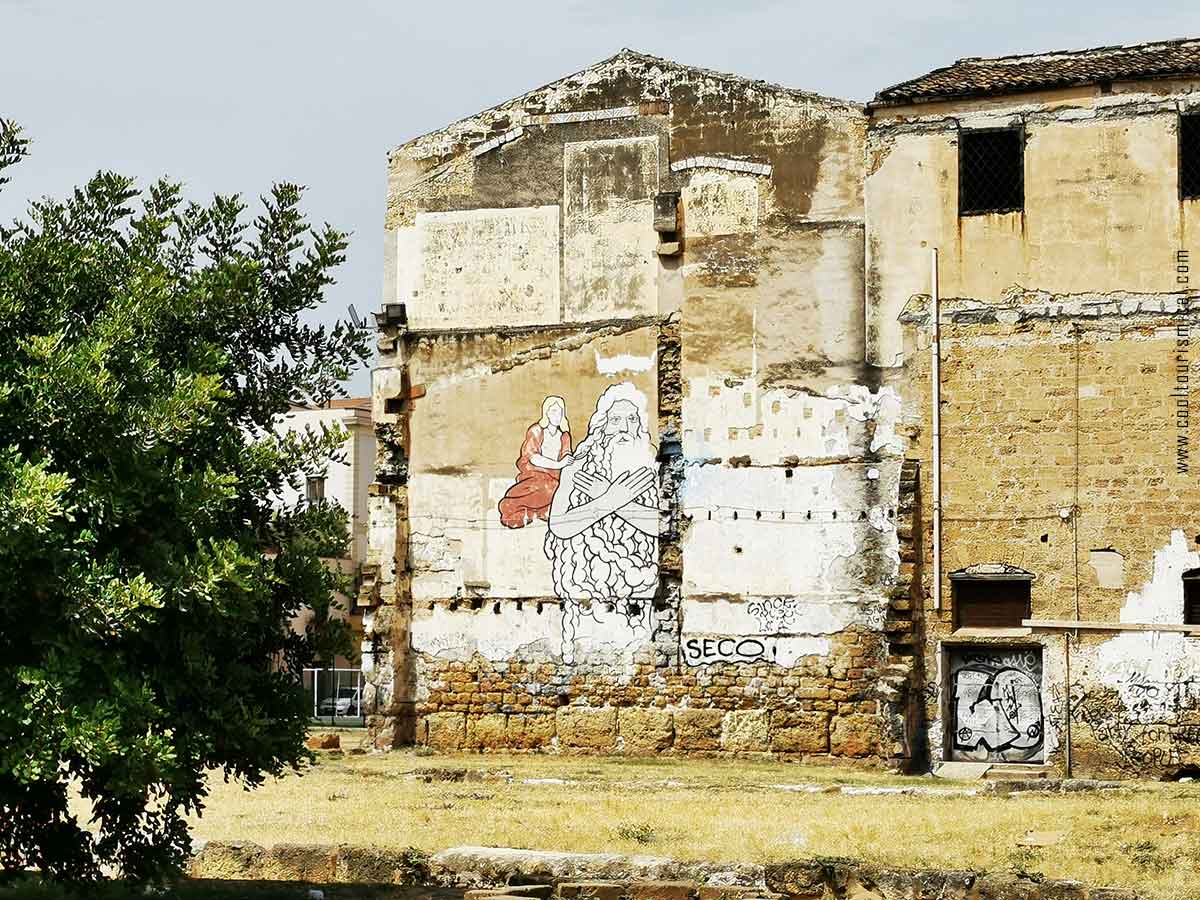
Street Art in Piazza Maggione, Kalsa District, Copyright © Cooltourismical.com
Palermo is not only a walkable city, allowing visitors to see some of the most amazing architectural masterpieces of Southern Italy, and some of the most interesting street art, but has one stunning natural scenery too.
Due to its location, the outdoor activities come in a great variety which is another great reason to visit Palermo. Its charm extends beyond the urban landscape, as it is also surrounded by breathtaking natural scenery, both sea and mountains.
Either you like sightseeing and walking on the crowded, old streets, swimming and sunbathing, hiking or diving, Palermo has them all.
In the city, as you wander down the main streets, you’ll find yourself many times weaving between scooters and cute three-wheelers in search of a palace, caught in the crowds of the ancient markets, or wandering through some exotic parks. On foot or by riding in an Ape Piaggio, a horse-drawn carriage, or a small tourist train.
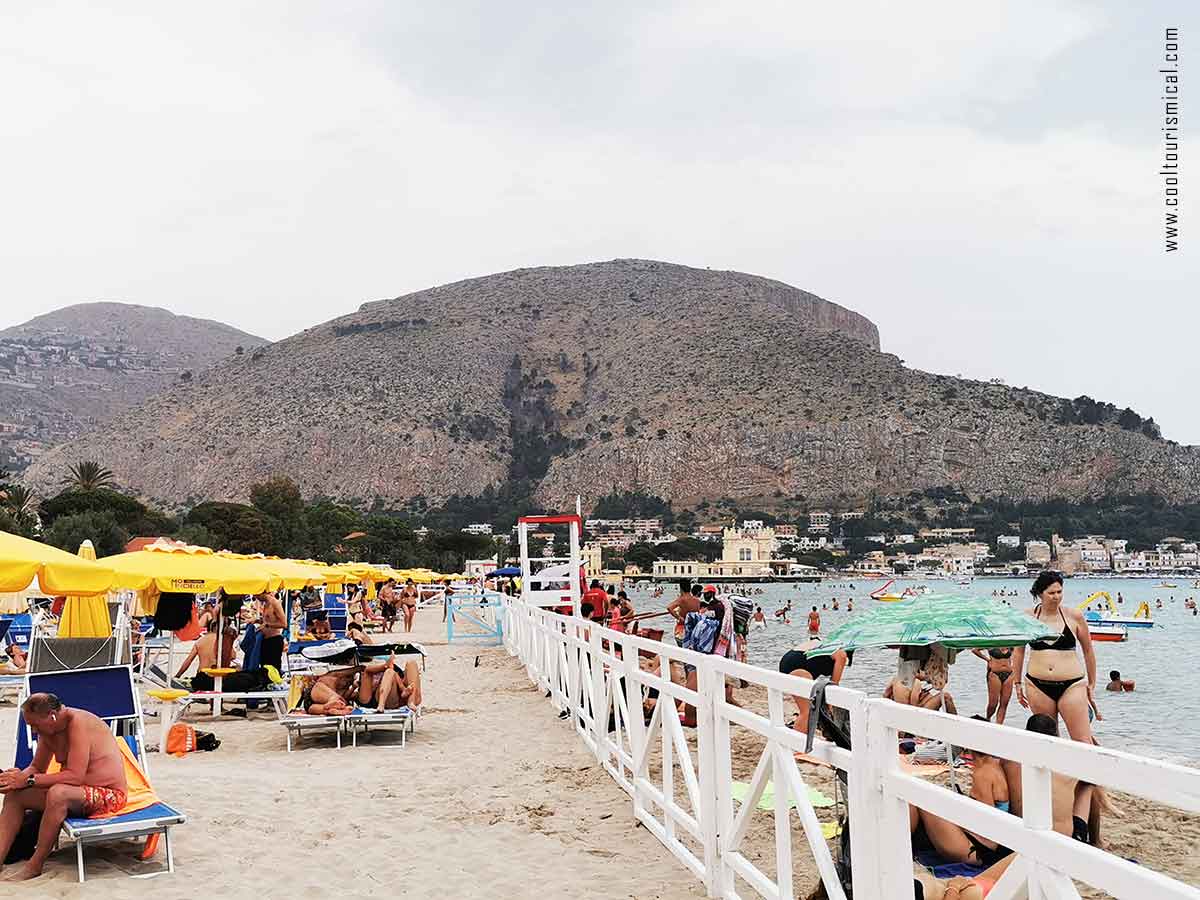
Mondello Beach, Copyright © Cooltourismical.com
Out of the city, the nearby beaches, such as the picturesque Mondello Beach, are ideal for sunbathing and swimming. Stretching 1.2 km along the coast and located just a 30-minute bus ride from Palermo’s city center, Mondello Beach is flanked by the Capo Gallo Natural Reserve and its extraordinary, hard to access Grotta dell’Olio, ideal for snorkelling, on one side and the Mount Pellegrino on the other, which is quite an excellent hiking opportunity.
Beyond Mondello, the region is filled even more natural wonders. Serre della Pizzuta Natural Reserve, situated about a 40-minute drive southwest of Palermo, and the north-western Molara Grotto and Capo Rama Natural Reserve, are both excellent destinations for nature in search for a peaceful retreat.
 Because You Must Have Seen The Godfather
Because You Must Have Seen The Godfather
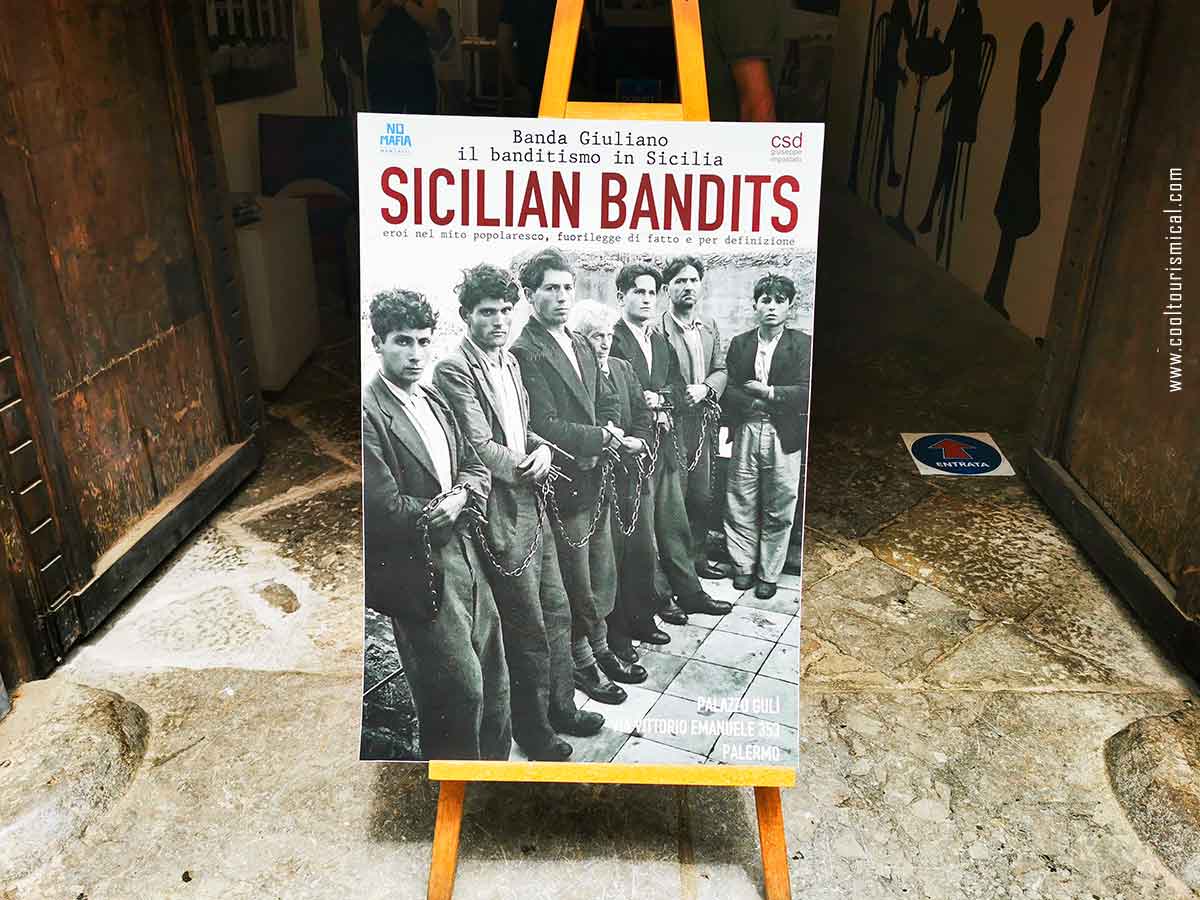
No Mafia Memorial Palermo, Copyright © Cooltourismical.com
We’ve all seen it. But that’s mostly fiction. The story behind is a painful truth, much more powerful and way beyond a cinema movie. Something that marked the life of so many Sicilian. And it’s about fight for justice.
Well, when I went to Palermo I knew little to almost nothing about its crime history. Cosa Nostra, which emerged in this city, seemed like a far-away concept from an old movie I had once seen as a child. Maybe that’s what made it even more interesting. However, for the locals this is a very sensitive subject.
My first interaction with Mafia history started at No Mafia Memorial, inside Gulì Palace, where walls tell endless stories of crime, struggle, and sacrifice. The second encounter was with the anti-mafia movement at the L’Emporio. This is a store selling products of small local business, part of the AdioPizzo, a network refusing to pay protection money to the Mafia. The store is filled with Sicilian goodies from all around the island.
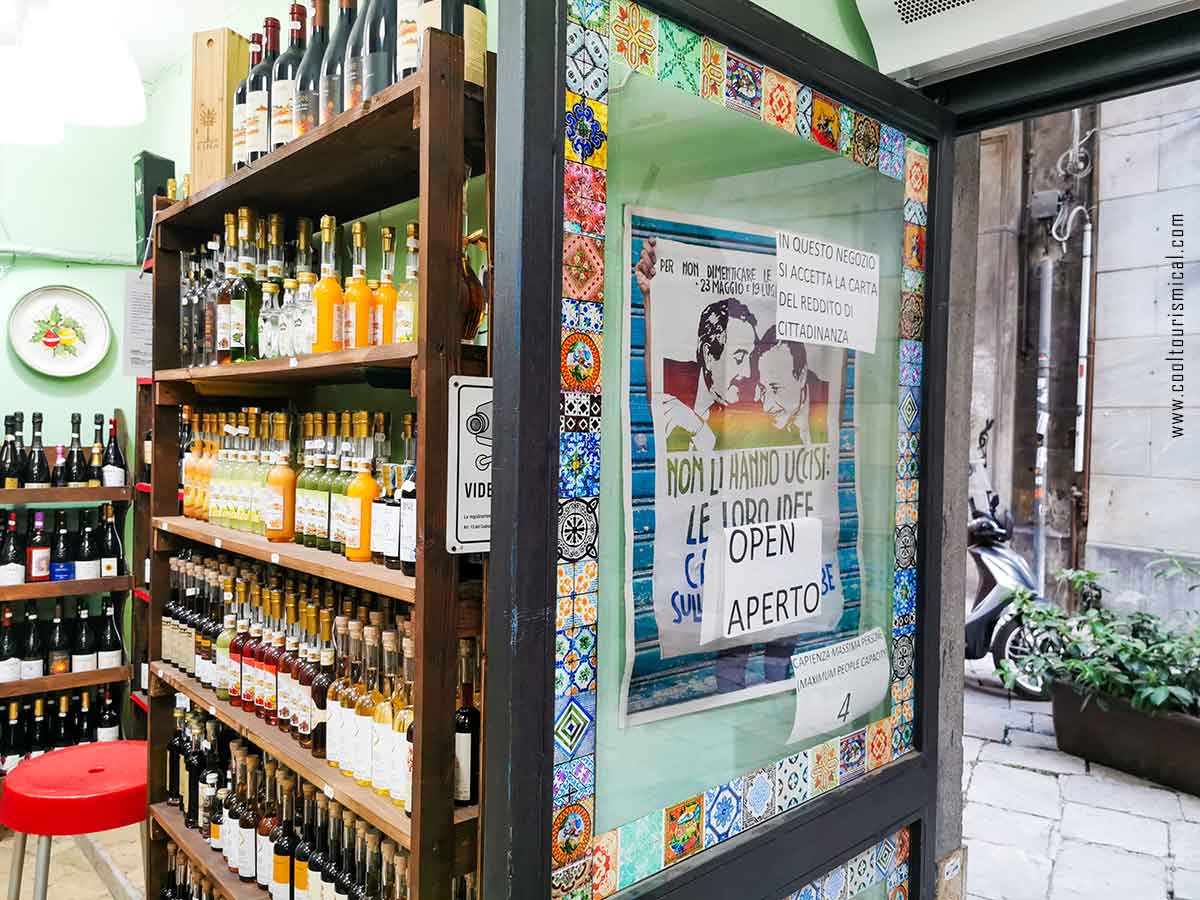
Borsellino & Falcone Poster @ L’Emporio, Copyright © Cooltourismical.com
But if you are into the cinematic part, you can always try some tours led by Palermo locals taking you to the actual places used in Francis Ford Coppola’s “The Godfather” trilogy.
These tours include iconic locations like Teatro Massimo or the terraces of Palazzo Sovrana in Palermo, where the end scenes from “The Godfather Part III” were shot, as well as the picturesque village of Corleone. If you’re heading for Taormina also, there are some tours of Savoca and Forza d’Agrò, chosen for some scenes in the film saga for their timeless charm over the modernized Corleone. Highlights include Bar Vitelli and the church from Michael Corleone’s wedding.
However, visiting Palermo offers a one in a million chance to see the real Sicily, which is completely different from the film’s romanticized portrayal.
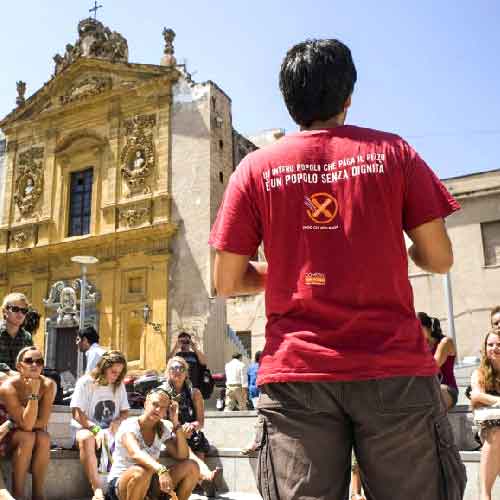
📌 No Mafia Movement Related Tour
Discover the history and struggles of the city while rebelling against Mafia.
- 🎟️ Admission ticket: GetYourGuide
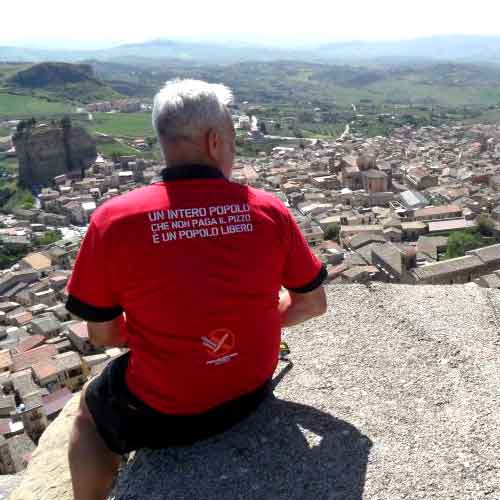
📌 Corleone Tour: Beyond “The Godfather”
Little town nestled in the Sicilian countryside renowned for its mob violence.
- 🎟️ Admission ticket: GetYourGuide
 Because Palermo Is a Safe City, Yet Underrated
Because Palermo Is a Safe City, Yet Underrated
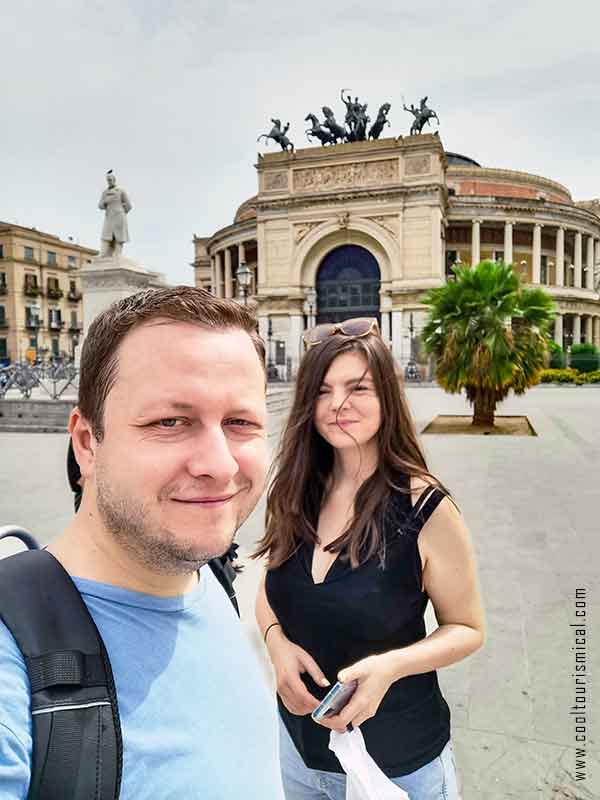
Us, Copyright © Cooltourismical.com
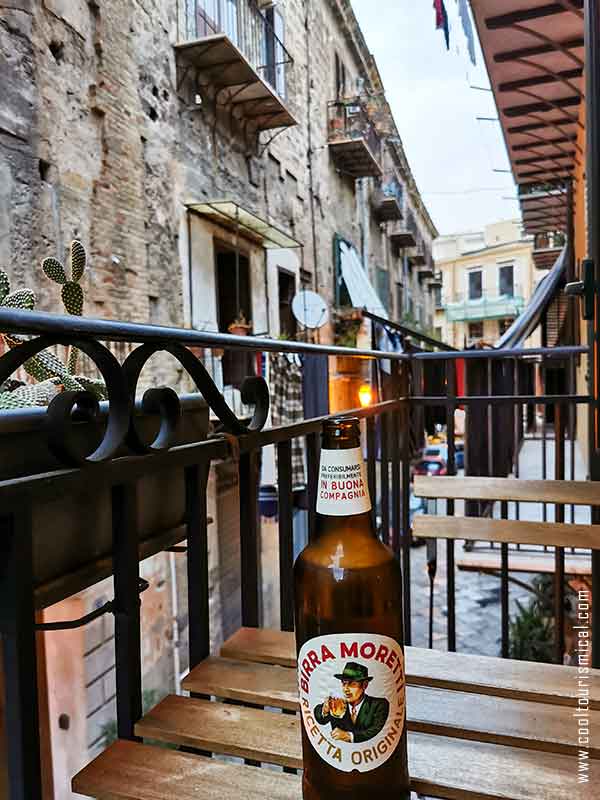
Our Tiny Balcony, Copyright © Cooltourismical.com
Today, Palermo is considered a safe city, making it an attractive and wonderful destination for tourists. As with any large city, it’s wise to take the usual safety precautions, but Palermo is now as safe as other major cities.
Fear of crimes, particularly those linked to the Mafia’s violent history in recent centuries, does not reflect anymore the city’s present safety situation. With the help of local authorities and the anti-mafia movement, people have been steadily reclaiming their city for the past 2 decades. Quoting the Guardian, “Today the Sicilian mafia is way less dangerous than before. Today we can say that the mafia – the one capable of killing magistrates and attacking the state – has been defeated.”
And data from ISTAT (Italian National Institute of Statistics) confirms it. According to them, Palermo has a lower per capita crime rate compared to other Italian cities like Milan or Rome. Actually, Palermo is a Bohemian, lively city which did not make the European top lists even for pickpocketing.
My latest trip to Palermo was a 7-day couple holiday. And we did not feel in any kind of danger at any time of the day or night. In the evenings, we were visiting mostly central areas and Vucciria market, but we were always heading back to our accommodation before 11 pm.
- 🔦 Safety tips: avoid engaging with street hustlers, showing off valuable items, and walking in areas that are less populated or dimly lit at night. As a pedestrian, always remain vigilant in crowded places to prevent pickpocketing and traffic chaos accidents.
To wrap up, I sincerely hope you’ll choose Palermo as your next destination. This city promises an unforgettable journey into the authentic heart of Sicily. If you have any questions, feel free to leave me a comment, and I’ll do my best to help you plan your visit.

